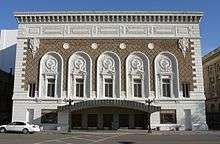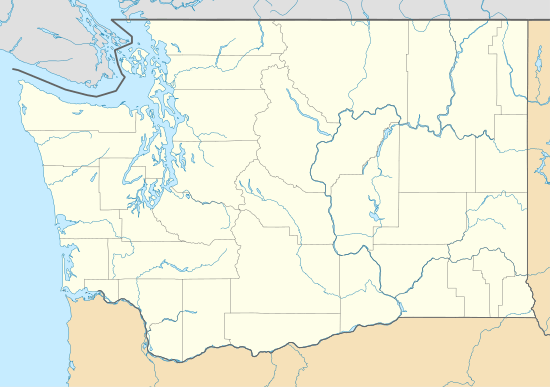Capitol Theatre (Yakima, Washington)
The Capitol Theatre is a performing arts venue in Yakima, Washington. With its location in downtown Yakima and 1,500 seating capacity, it serves as the primary performing arts facility for the Yakima region.[2]
Mercy Theatre | |
 The exterior of the Capitol Theatre | |
%26groups%3D_1bad634b69cd9769c20667bf991a30a4f6fd227e.svg)
| |
| Address | 19 S. 3rd St. Yakima, Washington United States |
|---|---|
| Owner | City of Yakima |
| Operator | Capitol Theatre Committee |
| Capacity | 1,500 |
| Current use | Performing Arts Center |
| Construction | |
| Opened | 1920 |
| Reopened | 1978 |
| Rebuilt | 1975 |
| Website | |
| www | |
Capitol Theatre | |
 | |
| Coordinates | 46°36′8.58″N 120°30′8.5″W |
| Architect | B. Marcus Priteca |
| Architectural style | Renaissance |
| NRHP reference No. | 73001895 |
| Added to NRHP | April 11, 1973[1] |
History
The Theatre was designed by B. Marcus Priteca and opened on April 5, 1920 as the Mercy Theatre, named after its owner, Frederick Mercy, Sr, who earned his wealth in the theater business.[3] At the time of its construction, the Mercy Theatre was the largest theatre in the Pacific Northwest.[4] The theatre originally featured vaudeville acts and is currently home to the Yakima Symphony Orchestra, Town Hall Series, Community Concerts, as well as traveling Broadway musicals.
In 1972 the Allied Arts Council and the City of Yakima began working together to transfer the building to public ownership. Part of this effort included successfully placing the theatre on the National Register of Historic Places in 1973. Shortly after ownership was transferred to the City, the building was severely damaged by a fire in 1975.[5] The building was severely damaged by the blaze, except for the stagehouse, which was virtually untouched, with only the walls of the audience section remaining standing; one of the few items saved from the fire was a Steinway grand piano, which had been signed by Henry Steinway, the president of Steinway and Sons.[6] Subsequently, the theatre was painstakingly renovated to its original 1920s state, although a basement with restrooms and a meeting room was added. Famed artist, Anthony Heinsbergen —who had painted the original murals on the Theatre's ceiling as his first paid commission—came out of retirement to repaint the dome. This was his last commissioned work. The rebuilt Theatre was completed in 1978 and the gala re-opening ceremony, which featured a performance by Bob Hope, was sold out.[7][8]
Gallery


 The interior of the theatre
The interior of the theatre
 the stage
the stage
References
- "National Register Information System". National Register of Historic Places. National Park Service. April 15, 2008.
- "Yakima Entertainment & Arts - Yakima Valley, WA". Yakima Valley Visitors and Convention Bureau. Archived from the original on 2007-01-04. Retrieved 2007-01-22.
- Yakima Centennial Commission. Yakima: A Centennial Perspective (1885-1985). Franklin Press: Yakima, 1984. p. 37.
- "About Us". The Capitol Theatre. Archived from the original on October 16, 2005. Retrieved 2007-01-22.
- "Yakima's Capitol Theatre". Yakima Valley Visitor Guide. Archived from the original on September 27, 2007. Retrieved 2007-01-22.
- Yakima Centennial Commission. Yakima: A Centennial Perspective (1885-1985). Franklin Press: Yakima, 1984. p. 37.</
- Yakima Centennial Commission. Yakima: A Centennial Perspective (1885-1985). Franklin Press: Yakima, 1984. p. 37.</
- "Capitol Theatre". Cinema Treasures. Retrieved 2007-01-22.
External links
| Wikimedia Commons has media related to Capitol Theatre (Yakima, Washington). |

